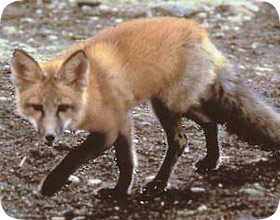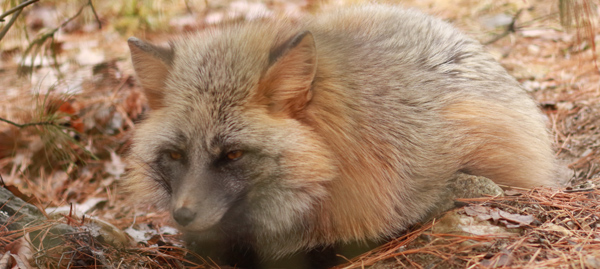- info@wildlife-removal.com
Call us for help in your town
Wildlife Removal Education
Fox Removal and Control
Need fox removal in your hometown? We service over 500 USA locations! Click here to hire us in your town and check prices - updated for year 2021.
 Fox are usually classified as a pest species due to their predation habits. Most common complaints include the following:
Fox are usually classified as a pest species due to their predation habits. Most common complaints include the following:
- Fox living under a deck or shed
- Fox preying on chickens
- Fox posing threat to pet
- Fox digging up garden
FOX NUISANCE CONCERNS:
Foxes are somewhat of scavengers and will therefore eat whatever they can find. They dig in gardens and under homes as well as eating pet food and other leftover garbage that has been left out unsecured.
They may attack small pets on occasion. Their loud yelling/screeching can be annoying for residents living close by. They sometimes prey on chicken coops. They also sometimes den under human structures,
such as a deck, shed, porch, or crawlspace, and have their pups. Other than that, they're relatively harmless. They're mostly shy and secretive animals.
FOX DISEASES:
Foxes are carriers of rabies. They are carriers of the tape worm parasite which can be transmitted to humans and take up residence in the intestines. They can also cause Sarcoptic Mange which results in the development of rashes in humans. Read the guides How to Tell if an Active Fox is Sick or Rabid and Diseases Foxes Carry and Their Symptoms.
HOW DO I GET RID OF FOX & COYOTES?
There are several techniques from prevention to scare tactics, as seen on how to get rid of a fox, but the best method is trapping and removal. Many wildlife control specialists excel at canine trapping. In many areas, it's a lost art, since not as many people fur trap as in ye olde days. However, many nuisance trappers
have learned to adopt the fur trappers' techniques in order to catch these animals. Some wildlife operators are in fact former (or even current) fur trappers. There are many techniques, some of which I consider inhumane,
and some of which are antiquated. For more information about trapping, read my how to trap a fox - trapping tips page.
CAN'T I JUST USE A REPELLENT?
There is no known effective repellent to keep fox off of a property, but there are steps you can take to keep foxes away. Read my fox repellent and prevention page for more info.

FOX BIOLOGY:
The Red Fox (Vulpes vulpes)is a fairly small wild canine. It can vary in color, from orange to gray to silver or black. Foxes are omnivorous (eating both plant and animal) animals having a brushy tail and a long narrow snout. There are a total of 37 species of foxes with a natural life of about 10 years for almost all of them.
They have a smaller build when compared to domestic dogs, wolves and jackals. The male foxes, known as Reynards, weigh around 13lbs while the female foxes – or Vixens - weigh around 11.5lbs. A male fox can be
around 26 to 29 inches in length with a tail length of 16 to 18 inches while a female fox can be around 24 to 27 inches in length with a tail length of 14 to 18 inches.
FOX BEHAVIOR: An interesting thing to note here is that there are different characteristics of foxes based on the environment they are living in. A fox living in a desert area has large ears and short fur while a fox living in snowy areas has tiny ears and thicker fur for protection against the harsher elements. Foxes live in small families and hunt rodents for their food. They also like consuming grasshoppers and fruits. The grey fox species can actually climb trees. Foxes also tend to hide and store their food to help get them through times when food sources are not as readily available.
Foxes are not friendly with humans; however, they do not confront or attack humans either. In fact, there have been only a handful of cases where a fox has attacked a human being; and those may have been because of feeling threatened or frightened. Read my
are fox dangerous to people or pets? page for more info. They can run at a speed of up to 42 miles per hour and have an acute sense of sight, smell and hearing. Like many other creatures, they prefer to hunt at night and stay in their dens during the daylight hours.
FOX HABITAT:
Foxes generally make more than one den to serve different purposes. The main den, which has several entrance and exit areas, is used primarily for breeding. The smaller dens usually have only one entry or exit point and have a long tunnel
stretching over 30 feet that connects it to the other dens. Although capable of digging burrows, they usually prefer to make their homes in burrows and dens made and abandoned by other animals. As such, they will often live in or under
human-built structures. If this is the case for you, read my fox under a shed, deck, or house page or read the guide What is the Fox's Habitat?
FOX LIFE CYCLE:
The life cycle patterns of foxes differ from the northern hemisphere to the southern hemisphere. For the northern hemisphere foxes, the female gives birth to four to five pups during the spring. The babies are deaf and blind at birth with a coat of fur for insulation. The mother fox stays with them while the father hunts and gathers the food. The cubs start coming out of the den after they are at least four weeks old. It is around this time that they start consuming solid food as well. During the summer, the parents abandon the breeding den and the cubs are taught the skills to gather food. By the time autumn comes, the pups have grown up to full adults and start their own separate life. By the winter season, the young adult foxes are ready to mate.
Additional articles:
how to catch a fox
how to kill a fox
are foxes good pets?
should you poison a fox?
Foxes
There are more than 12 species of foxes. They typically have smaller bodies than other animals in the family Canidae (wolves, domestic dogs, and jackals). Foxes are generally known for their intelligence and cunning.

Appearance
Besides a general resemblance to dogs, foxes are known to have concave shaped heads as opposed to the convex shaped heads of the domestic dog. They have big, almond shaped eyes as well as large, triangular ears which are used to detect their prey as far as 40 yards from their current location, a pointed snout, and a long bushy tail. The tail provides balance and warmth from cold conditions.
Foxes have 2 layers of hairs - the outer guard hairs and the layer shielding hairs; the layer shielding hairs serve for protection. Hair colors vary in foxes with black, white, grey, and orangey brown commonly occurring in the combinations; they have also been known to adapt the color of their hair to their environment. Majority of the species, like the ones found in North America have short legs and bushy tails.
Their body sizes vary from 9 inches (23cm) to 34 inches (86cm) if the measurement is taken from the flank up to head. The tail adds up to 12 inches to 22 inches to the head to flank measurement. Most foxes weigh between 1.5 pounds to 24 pounds, that is, 0.68kg to 11kg.
Habitat
Foxes are found in every continent of the world, except Antarctica. Most of the species are localized in North America, Europe, Asia and North Africa, where they reside on mountains, in forests, on grasslands and in deserts.
Wherever they occur, foxes dig burrows. These burrows are referred to as dens and they serve three purposes altogether - sleep, storage mostly of food, a reproduction site.
Behavior
Some foxes live in small groups called packs, while others like the Arctic foxes are solitary dwellers. Communal foxes mark the spots that they visit with a urine scent, which serves as a means of communication to others, especially if there is an abundance of food in the area.
Foxes are mostly nocturnal predators and they hunt their prey with a pouncing technique in which they crouch in a hidden spot and then spring out with their hind feet to land on top of the prey with force. They store excess food under vegetation or soil for later consumption.
They have partially retractable claws that help them to climb trees (grey foxes), and they usually walk on their toes. Foxes have been known to leap up to 6 feet on unsuspecting prey and they are the headache of many a poultry farmer, whose fences never seem to be high enough to prevent a fox raid.
Diet
Foxes consume a wide variety of food. They eat invertebrates such as insects, small vertebrates such as reptiles, birds, and mammals; and sometimes eggs and plants. Common foods include on snakes, birds, amphibians, lizards, voles, rats, hares and so on.
They have large and sharp canines with which they kill and tear into their prey.
Reproduction and Life Cycle
Foxes give a characteristic high-pitched shriek or scream when it is time to mate. After mating, the female fox (vixen) enters a gestation period of about 52 days, and give birth to an average of four to five young ones known as pups (or kits or cubs). The arctic fox gives birth to up to eleven pups. Reproduction takes place once in a year normally.
The den is lined with leaves to form a special nest in which the dominant female gives birth and cares for the pups. The vixen has four pairs of teats, from which the young are nourished
A lot of cubs die prematurely in the hands of predators like dogs and badgers, but even more die from being run over by motor vehicles. They sometimes also die of starvation or cold during hard winters.
Go back to the Wildlife Removal home page.


















